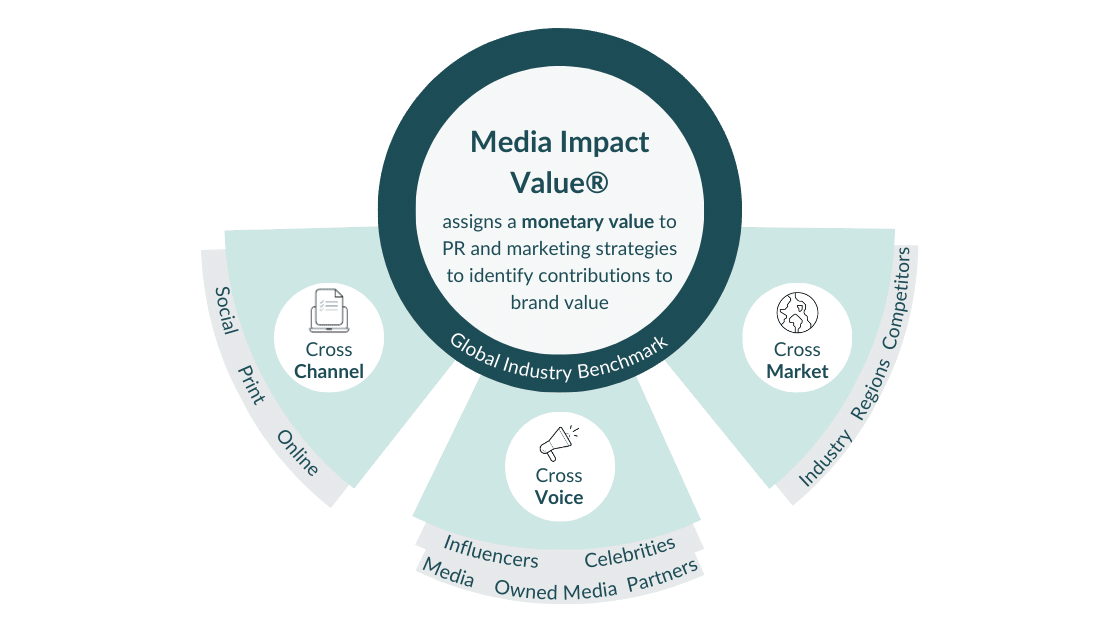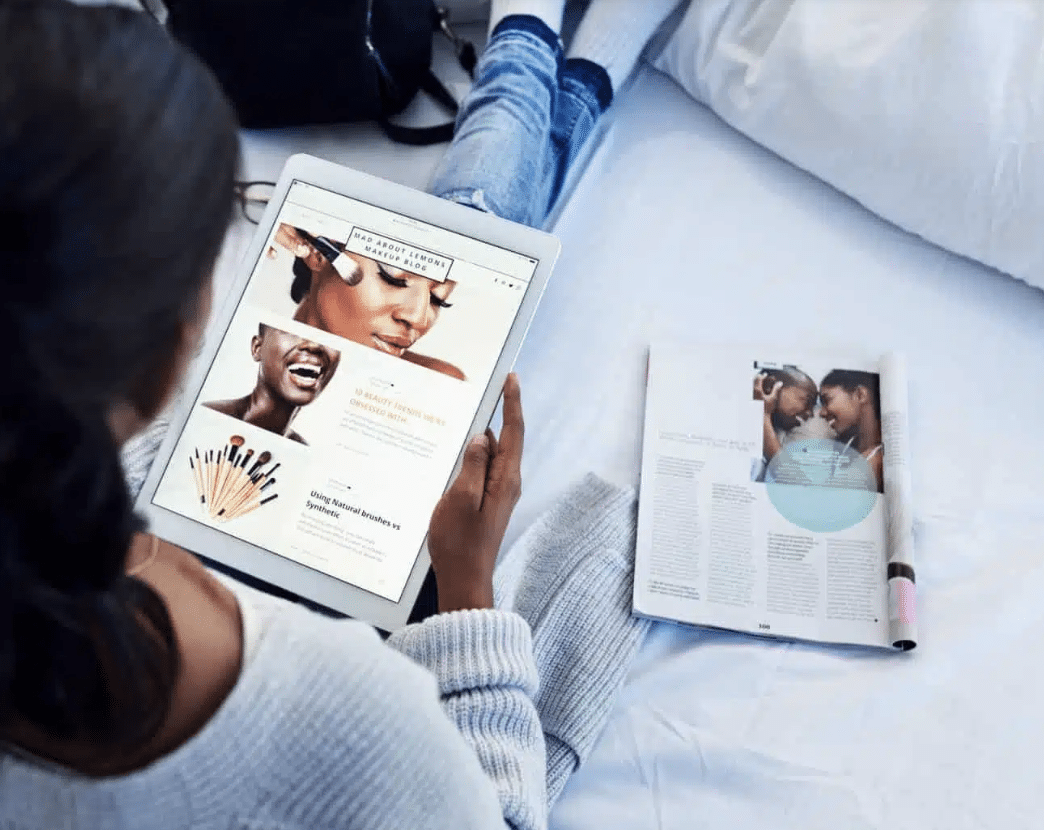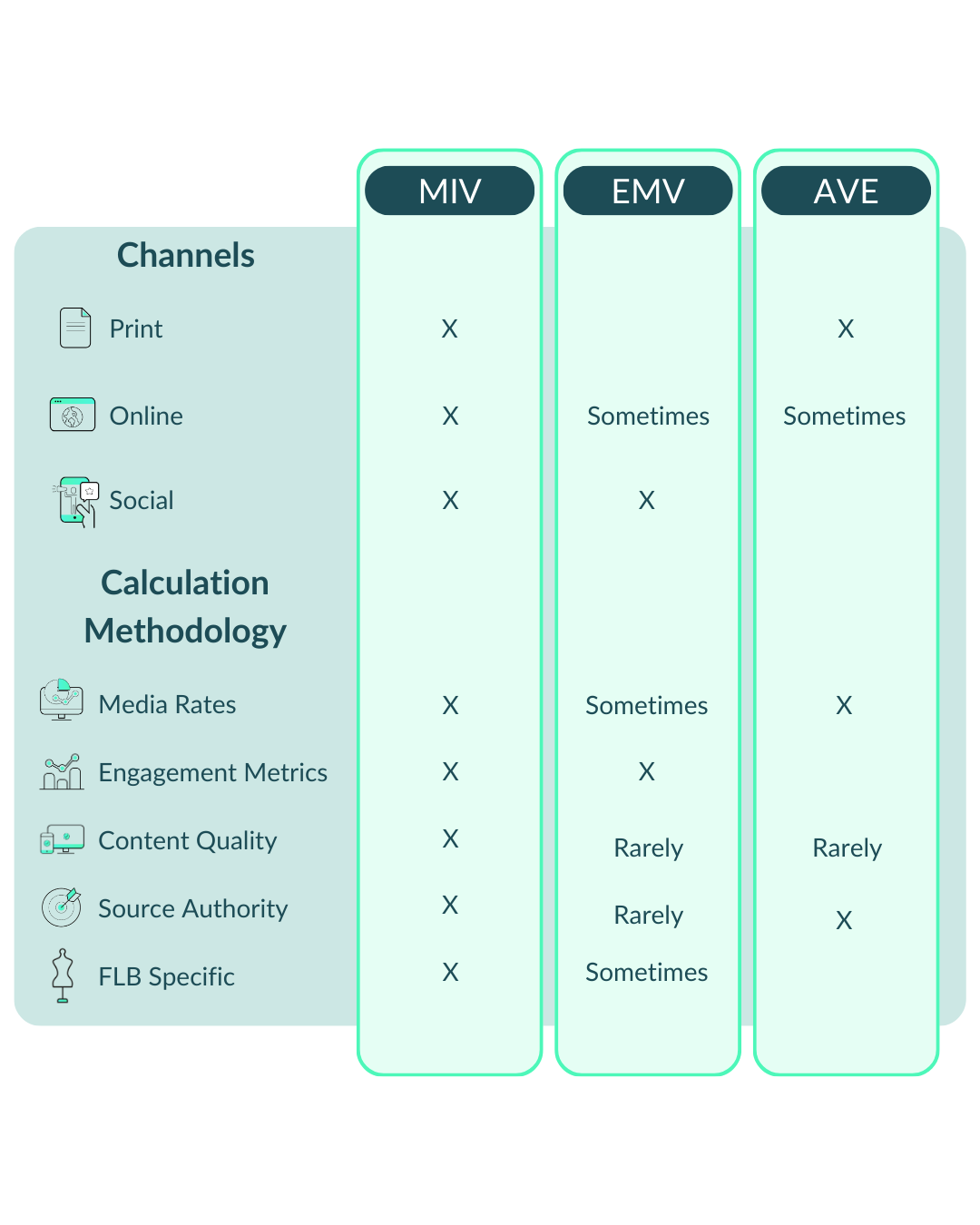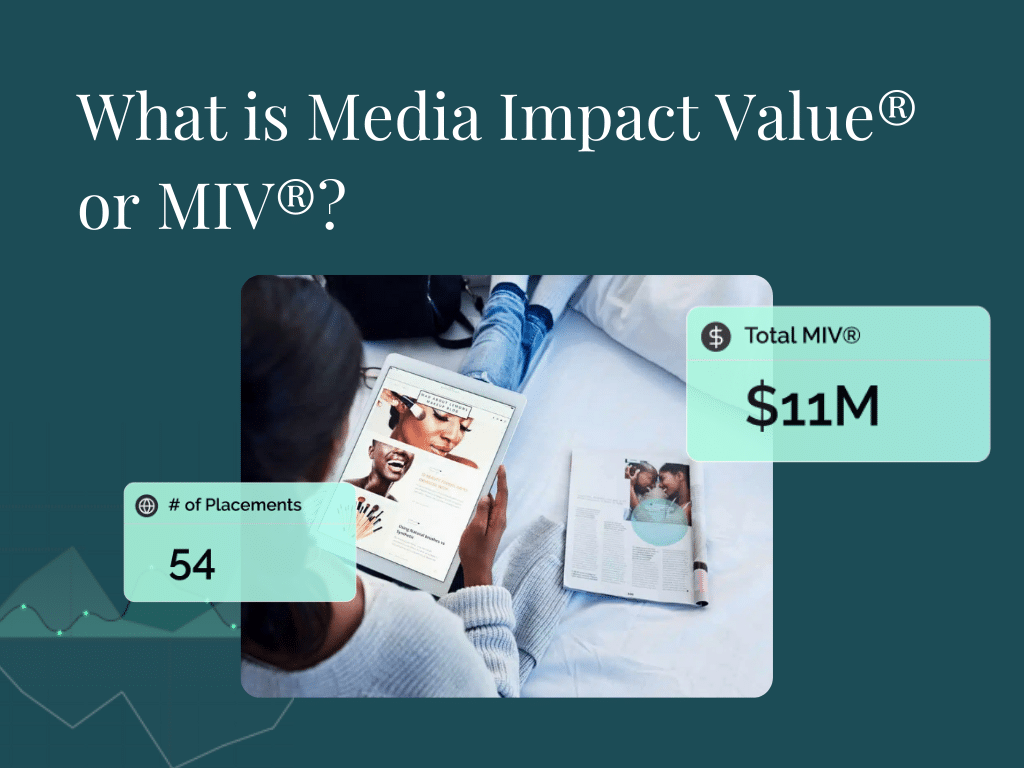Imagine an influencer posting a single photo from the Met Gala or a red carpet moment at the Oscars—and suddenly, you’re seeing headlines about how they generated millions of dollars in MIV for a brand just by posting about it. But what does that really mean? Let’s break it down.
Media Impact Value® (MIV®) is a powerful metric that assigns a monetary value to media mentions across social media, online publications and other channels—helping brands quantify the impact of media exposure.
In this article, we’ll break down what MIV is, how it's calculated and why it has become a go-to benchmark for Fashion, Lifestyle and Beauty (FLB) brands.
In this article you’ll learn…
What is 'MIV'? A Deep Dive
MIV—or Media Impact Value—is a proprietary algorithm created by Launchmetrics to measure and benchmark the impact of all media placements and mentions across different Voices (Celebrities, Influencers, Media, Owned Media and/or Partners) in the Fashion, Lifestyle and Beauty industries.
By leveraging MIV, you can compare the impact of each post shared across print, online and social channels. This allows you to measure the ROI of any PR and/or marketing activity that you create and execute.
Here’s an example of MIV in practice…
In our Spring/Summer 2025 Fashion Week Data & Insights report, we broke down the top Voices at each of the “big four” fashion weeks. For New York, the top Celebrity was Pia Wurtzbach, who generated a total of $6.8M in MIV—including $1.4M for Carolina Herrera and $1.24M for COS. In our ranking of top Voices overall, Vogue US beat out Pia to land the number one spot, generating $15.8M in MIV during the event (and proving that traditional media still hold plenty of clout in the fashion world). Our data also reveals that 66% of Vogue’s MIV was driven by its social media activity.
Using MIV as a benchmark metric, we can see how brands can view (in monetary terms) the buzz generated by celebrities and influencers wearing their creations or attending their events. By analyzing MIV, brands can compare the effectiveness of their strategies, identify high-performing Voices and refine their approach for future campaigns. Additionally, MIV allows a brand to compare results across various Voices, media types, channels, time periods, products, regions and more. Moreover, its comparative capabilities mean brands can actually benchmark their performance against their competitors, as well as review omnichannel strategies to understand which channel or media type is overperforming or where there can be improvements.
MIV Meaning & Definition: At a Glance
MIV stands for ‘Media Impact Value’. It is a proprietary metric used to measure the impact of brand mentions across various Voices and channels. It assigns a monetary value to exposure from social media, online publications and other media sources, helping brands assess the effectiveness of their PR and marketing efforts.
MIV is widely used in the Fashion, Lifestyle and Beauty (FLB) industries to quantify brand visibility, track campaign performance and compare media impact across different platforms.

The Role of Voices in MIV: Taking a Voice-Centric Approach
As well as measuring media exposure, MIV helps brands understand who is driving the conversation. We refer to this as a Voice-centric approach. Rather than treating all media mentions equally, MIV categorizes contributors into five distinct Voices, namely Celebrities, Influencers, Media, Partners and Owned Media. By segmenting media sources in this way, brands gain a clearer picture of which Voices are delivering the most value and can adjust their strategies accordingly.
For example, a high-profile Celebrity wearing a brand on the red carpet might generate millions in MIV through widespread media coverage and social sharing. Meanwhile, an Influencer with niche authority could provide more targeted but highly engaged exposure. Traditional Media outlets like Vogue or Harper’s Bazaar also contribute significant MIV, especially through long-form editorial content that reinforces brand positioning. Brands can compare these different Voices to see which sources align best with their marketing goals.
The ability to analyze media impact across different Voices and platforms is what makes MIV such a powerful benchmark. A brand can track how its paid placements compare to earned influencer mentions, or evaluate how its own social media channels stack up against third-party media coverage. By leveraging MIV’s Voice-centric insights, companies can fine-tune their marketing mix to prioritize high-impact partnerships and ensure they’re investing in the channels that yield the highest return.
Why Was Media Impact Value Created?
Media Impact Value was formulated to address some of the challenges that the Fashion, Lifestyle and Beauty industries were facing when it came to measuring brand performance.
For example, the lines between print, online and social media have become increasingly blurred. So have the lines between paid, owned and earned media. How can you compare a placement in Vogue’s September issue against a backstage Paris Fashion Week post on TikTok? Measuring these different media formats was difficult, and they were almost incomparable.
Reach and engagement metrics only tell part of the story when measuring results. Understanding which activities generate the highest return on investment (ROI) is essential for shaping effective brand performance strategies. For instance, while partnering with a Micro Influencer with a niche audience may be a cost-effective collaboration, how does its impact compare to a media mention in a niche publication? MIV provides a valuable framework for quantifying and comparing these different touchpoints, helping brands assess their true contribution to brand awareness and future strategy.

How MIV Compares to Other Earned Media Metrics
While MIV was created to address challenges in measuring brand performance, it builds on traditional metrics that have been used for years to assess media impact. Methods like Advertising Value Equivalency (AVE) and Earned Media Value (EMV) have long attempted to quantify brand exposure, but they come with limitations. MIV refines and enhances these approaches, offering a more sophisticated, data-driven way to measure the true impact of placements. .
AVE and EMV rarely take the quality of the content into account, and neither assesses earned media across both print and online as well as social.

To better understand how these metrics compare—and why MIV is becoming the preferred standard in FLB—check out our guide: How to Measure Earned Media Value: AVE, EMV and MIV Explained.
Who Uses MIV?
MIV is widely used by brands, agencies and media professionals in the Fashion, Lifestyle and Beauty (FLB) industries to quantify the impact of their marketing and PR efforts. Luxury fashion houses, beauty brands and lifestyle companies rely on MIV to measure the effectiveness of media placements, influencer collaborations and event sponsorships. By assigning a monetary value to brand exposure across different channels, MIV helps these businesses understand which strategies drive the most impact and where to focus their resources.
PR and marketing teams use MIV to evaluate the success of earned, owned and paid media. It allows them to compare the value of a magazine feature with, say, a viral TikTok video or an influencer’s red-carpet look in real monetary terms. Instead of relying solely on engagement metrics like likes and shares, brands can assess the financial worth of media exposure, ensuring they make data-driven decisions about partnerships and content distribution.
Professionals who work in influencer marketing also turn to MIV to measure the true ROI of collaborations. Rather than just tracking reach and engagement, MIV provides insights into which influencers and content types generate the most tangible value. This allows brands to optimize their influencer strategy, ensuring they invest in Voices that contribute the highest impact.
Additionally, media analysts and industry researchers use MIV to benchmark performance against competitors, track trends across regions and identify emerging platforms or formats driving the most value.
How is MIV Calculated? Which Factors Does the Formula Include?
MIV is based on three main criteria, starting with the advertising or activation value equivalent x source-based factors x content-based factors.
The advertising or activation value equivalent is calculated using advertising rates for print articles that are usually publicly shared by most publications in their official media rate cards. For an online article, this is rooted in the AVE (Advertising Value Equivalent) where we rely on our learning set of more than 5,000 FLB online media publications with more than 10k brands that we have worked with. It is then adjusted based on the overall quality of mentions. This ensures that placements from more sought-after sources are valued more than less attractive sources.
Across social, we consider the influence of a social account by individual metrics, such as the number of followers, likes and shares across each platform. All in all, this criteria takes into account the audience as well.
‘Source-Based Factors’ reviews the media type, the relevance of content directly related to Fashion, Lifestyle and Beauty topics, and the overall media quality score, looking at a set of 4k+ top media sources. For social, the post frequency is taken into consideration as well as the Voice type, whether the post comes from a celebrity, brand, influencer or consumer.
‘Content-Based Factors’ takes into account engagement metrics (e.g., likes and share counts) as well as the type of content. The length, size, positioning and presence of images or videos can all make an impact on the content quality.
So, MIV is calculated with these key criteria in mind, ultimately providing brands with a unified currency to measure the value of all marketing activities across Voices, Channels and Markets. By assigning a monetary value to each interaction and initiative, MIV simplifies benchmarking across different strategies, from influencer marketing to PR endorsements. As a true measure of media value, it offers a clear understanding of the ROI of marketing and communication activations.
Conclusion
With its Voice-centric approach and AI-powered methodology, MIV provides a standardized way to measure brand exposure across digital, print and social platforms. By incorporating both qualitative and quantitative factors, it offers a more accurate reflection of media impact compared to traditional metrics.As the FLB industries evolve, the need for a data-driven, monetary-based measurement has become more important than ever. With MIV as a benchmark, brands can move beyond chasing likes and shares to gain a deeper understanding of the true value behind every media mention.
